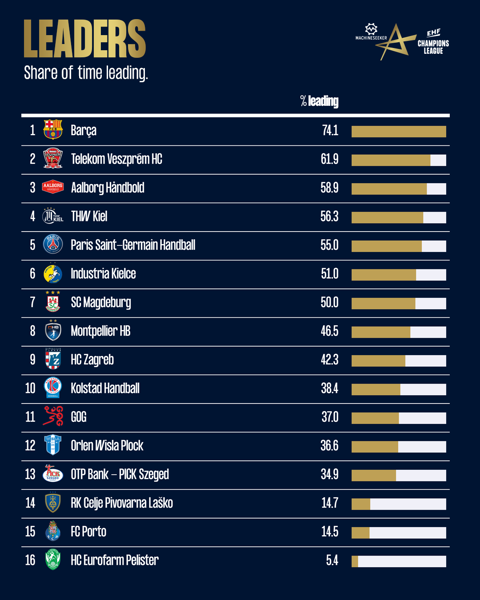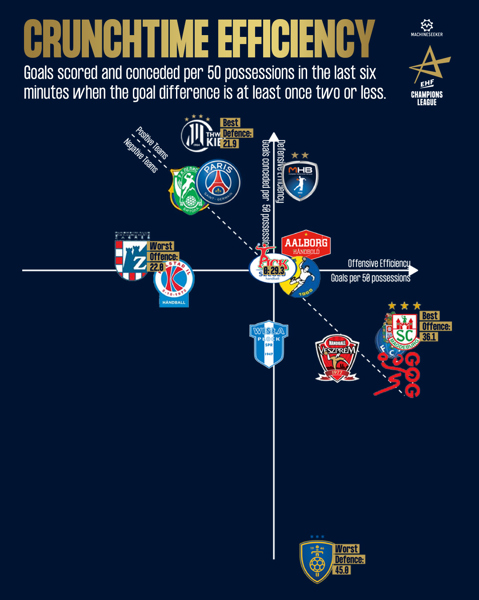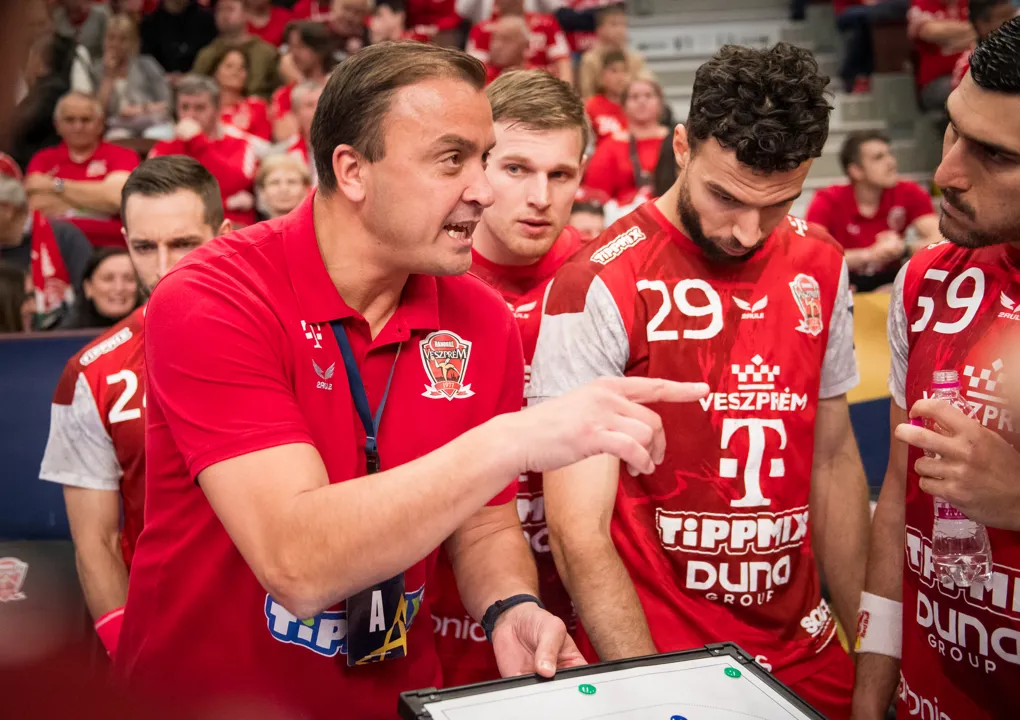In a thriller game last Thursday, Telekom Veszprém defeated Aalborg Håndbold 32:31 with a buzzer-beater by Yahia Omar. That last second goal marked the first lead that the Hungarian side had in the whole game, while they trailed by as many as six goals several times.
Despite this, over the whole season, Veszprém is the team that has the second-highest share of time leading this season: 61.9% of the time they played they were leading. So, the first leg was absolutely a negative outlier for them in that regard. The only other game this season when they didn’t lead for one second was their 30:37 loss against Orlen Wisla Plock.
Aalborg, however, rank third, just slightly below Veszprém with 58.9% of their playing time leading. The gap between the two teams has, of course, become much smaller as a result of the first leg.

For 55.2 minutes the Danes had the lead against Veszprém, the most any team had in a match they lost. The second most was RK Celje Pivovarna Laško against FC Porto, where they led 16:9 at half-time, but lost 29:30 in the end. FC Porto are in third place. After trailing 15:21 at half-time, they won 32:31 against GOG with 40.8 minutes behind. In total, Porto were 27.8 minutes behind Celje, who failed to pick up a single point, while the Portuguese team managed four wins.
Different halves
After losing the first half 12:17, Veszprém turned everything around with a 20:14 second half. The fact that more goals are scored in the second half than in the first is nothing special, however, it’s not much more. In the current season, 29.4 goals are scored per game in the first half, compared to a slightly higher 29.8 in the second half.
It becomes more clear after normalising both to 50 possessions. Although the first halves this season are played slightly faster, with 26.7 possessions per team compared to the second halves (26.4), this does not have a major impact in the end, with 27.6 goals per 50 possessions in the first half compared to 28.1 in the second half.
Using these statistics that are adjusted for possessions played is significantly more meaningful than just the raw number of goals (conceded) because it makes the teams actually comparable since the raw number of goals is not only influenced by efficiency, but also by the number of possessions (whether a team and their opponents play rather fast or slow). Since a game has roughly 50 possessions on average (53.1 this season), the values here are calculated on 50 possessions so that they roughly reflect those of a game.
Interestingly, this first leg was an outlier for both teams. Over the whole season, the two teams have performed well in both halves. There is no clearly better half for either team. In the first half, Barça is clearly the best team scoring 6.3 goals per 50 possessions, more than they concede. But, despite last Thursday's game, Veszprém are already in second place (+3.5), ahead of Aalborg, who are third (+3.1).
SC Magdeburg lead the efficiency rankings in the second half with 5.7 more goals scored than goals conceded per 50 possessions. Interestingly, second and third place are exactly the same as in the first half, with Veszprém in second place (+3.5), followed by Aalborg (+2.6).
Unusual crunch time
The comeback of Momir Ilić’s team last Wednesday is even more remarkable considering that crunch time hasn’t been their strength this season, while Aalborg were strong in this regard. Crunch time is defined as the last six minutes of a match if the gap between the two teams was two goals or less at least once. If the difference between the two teams grows to five or more goals, it is no longer crunch time.
For Veszprém, the first leg was just the fourth game this season that went into crunch time. Only Barça had less. For Aalborg, in turn, this was the ninth game this season that was decided in the last minutes. Only Industria Kielce had more.
There was not much sign of this bigger crunch-time experience on Thursday. With a 27:27 draw, the game went into the final six minutes, so Veszprém won the crunch time by one goal. Again, this is unusual for the whole season, as the Hungarian side had the fifth-worst crunch time goal difference. They score 32.6 goals per 50 possessions in crunch time (fourth-best) while conceding 34.1 (third-worst).

Stefan Madsen’s team may only score 31.0 goals per 50 possessions in crunch time, but they only concede 28.0. The difference of 3.0 is the fourth-best in the competition.
Even if this crunch time strength was not really noticeable in the first leg, it could be in the second leg. Because there is no more crunch time than a knockout game in which everything is at stake.
More from data analyst Julian Rux can be found at Handballytics.de. There you can read his latest articles, in which he analyses all kinds of handball topics from new, data-based perspectives. You can also find him on Instagram, Facebook, X/Twitter, Threads and WhatsApp Channels.
Photo © Roland Peka








